Did you know you can get one to six new onions from just one onion bottom? This shows how efficient regrowing onions can be. It turns kitchen waste into a lot of fresh produce. In this guide, you’ll learn how to grow onions from onions easily. These steps will help you grow onions well, whether you’re new to gardening or not.
Table of Contents
Introduction to Onion Gardening
Onion gardening is a rewarding hobby for both new and experienced gardeners. You can grow onions in gardens, pots, or window boxes. This way, you can enjoy onions in your cooking while growing them at home. Knowing what onions need is key to growing them well.
Onions do best in soil that drains well and has a pH of 6.0 to 6.8. Raised beds or rows help with drainage, which is important. Onions have shallow roots and don’t absorb moisture well. Plant them about 6 inches apart in rows that are 12 inches apart for healthy growth.
Using continuous-release plant food helps your onions grow well. Watching your onions grow teaches you a lot. For example, young seedlings with a pencil-sized diameter grow into bigger bulbs. Growing onions at home also lets you try different types, adding variety to your cooking.
Knowing how long onions take to grow helps with planning. It can take three to five months for onions to mature, depending on the type and climate. With the right care, like watering, weeding, and feeding, you’ll enjoy your onions when their tops turn yellow and fall over.
Why Regrow Onions?
Regrowing onions is great for the environment and your wallet. It turns kitchen scraps into fresh food. This method makes gardening more sustainable and saves money by providing a steady onion supply.
Using onion roots in water can make green onions sprout fast. They’re ready to eat in under six weeks. You can grow green onions up to five times before they get weak. It’s a fun way to try different onion flavors in your cooking.
Adding regrowing onions to your garden is good for your health. Onions are packed with vitamins and minerals. They help fight inflammation and cancer. Growing your own onions connects you to nature and improves your gardening skills.
Materials Needed for Onion Propagation
Starting your onion propagation journey needs a few key items. Having the right materials makes the process easier and more fun. Make sure you have everything needed to regrow onions successfully.
Essential Tools and Supplies
For onion propagation, you’ll need some important tools and supplies. These include:
- Fresh onion – choose healthy bulbs without decay signs.
- Clean knife – for making precise cuts.
- Cutting board – to protect your surfaces while preparing.
- Starter pot with potting soil – optional, but useful for indoor planting.
Having these tools ready makes your regrowing process efficient. Preparing these items is easy, letting you focus on the propagation.
Choosing the Right Onion Variety
Not all onions are good for regrowing. For the best results, pick firm onions like:
- Yellow onions
- Red onions
- Green onions
These onions do well in regrowing, giving you a steady supply of fresh ingredients. Whether you use green onions or red onions, the right variety improves your cooking and gardening.
Step-by-Step Guide on How to Grow an Onion from an Onion
Starting your onion-growing journey is exciting. You need to know a few key steps. These steps will help you get a big harvest. First, you must prepare the onions for growth.
Preparing Your Onion
Begin by cutting 1.5 to 2 inches from the bottom of the onion. Make sure to keep the roots intact. This step helps the new roots grow.
After cutting, let the onion pieces sit in a shaded, well-ventilated area. This can take a few hours to two days. It’s important for protecting the onion from rot and helping the roots grow strong. Use compost to make the soil rich with nutrients.
Choosing the Right Environment
Knowing what onions need to grow well is key. They love sunny spots and need at least 12 hours of sunlight a day. If growing indoors, place them near a sunny window or use grow lights.
The soil should be loose and drain well. Keep the temperature above 50°F. This helps the onion grow strong leaves and bulbs.
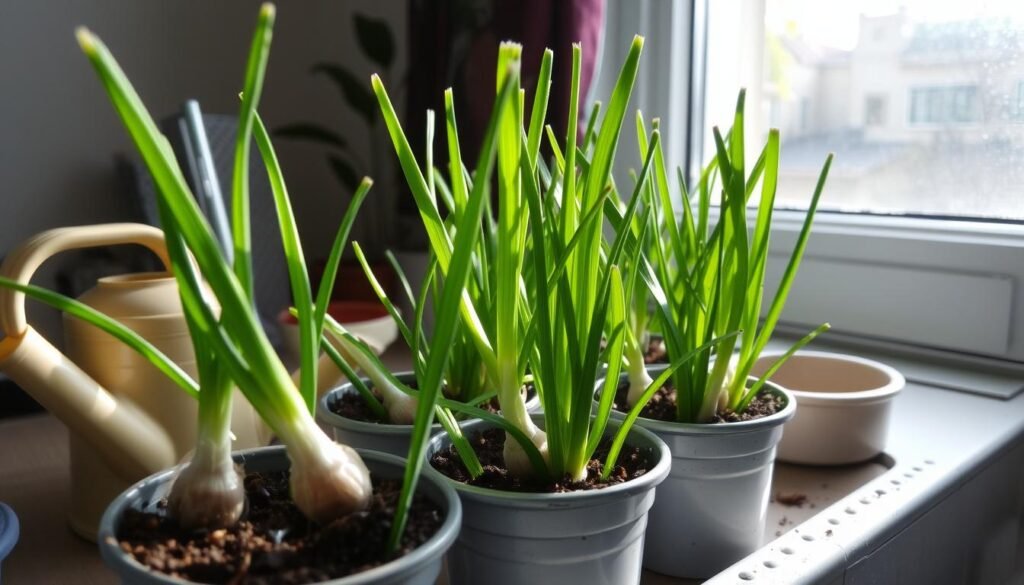
By following these steps and considering the environment, you can grow a healthy onion plant. Choose between planting seeds or sets based on your gardening needs. This will affect how long it takes for the onion to be ready to harvest.
| Onion Type | Ideal Growth Condition | Days to Maturity | Planting Time |
|---|---|---|---|
| Long-Day Onions | 14+ hours of daylight | 90-110 days | Early Spring |
| Short-Day Onions | 10-12 hours of daylight | 110 days | Late Winter to Early Spring |
| Day-Neutral Onions | 12-14 hours of daylight | 110 days | Late Fall/Early Winter |
Keep an eye on the soil and environment to get the best onion growth. Happy gardening!
Slice Off Onion Bottom for Growth
To start growing onions again, cut about 1 inch from the bottom. This part, with the onion roots, is key for new onion growth. A clean cut is vital for healthy roots.
After slicing, let the onion dry and form a callus before planting. This step helps prevent rot and ensures strong roots. Egyptian Walking onions are great for growing year-round.
You can grow these onions indoors in winter for greens. They also do well outdoors in loose soil. Remember, avoid too many nutrients from the onion bulb for best results.
| Key Data | Details |
|---|---|
| Recommended Cut Depth | 1 inch from the bottom |
| Watering Frequency | Every few days |
| Time to Bulb Formation | 60-80 days |
| Optimal Planting Season | Spring, fall, or early winter |
| Growth Aid | Soak for 3-5 days before planting |
This method not only boosts green growth but can also lead to small bulbs. With the right care, you’ll enjoy a rewarding harvest.
Allowing the Cut Onion to Callous
After slicing the onion, it’s important to let it callous. This step is key for healthy growth. Place the cut onion in a dry, well-ventilated spot.
Let it dry for 12 to 24 hours. This hardens the cut surface and prevents rot when planting.
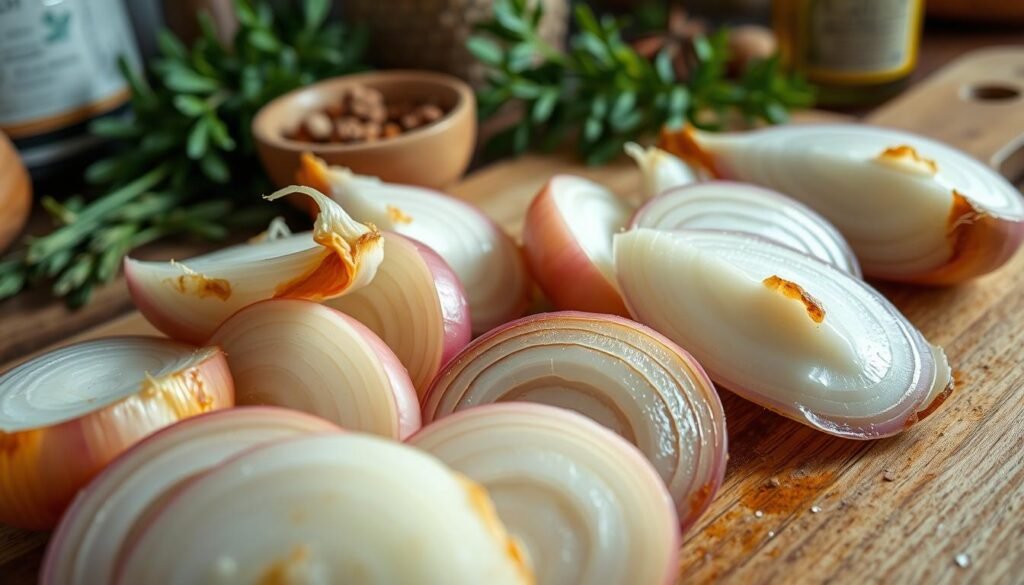
Ensuring the onion is well-calloused is vital. Each cut can grow into more than one plant. Focus on this step to boost your yield.
Avoid moisture during this time. It can ruin the callousing process. Well-calloused onions are more likely to thrive and give a good harvest.
Potting Your Onion Cutting
When growing your onion cutting, you can start them in pots or directly in the ground. Both ways can lead to great results, depending on what you prefer and how much space you have.
Using Starter Pots vs. Direct Ground Planting
If you choose to pot onions, pick starter pots with good drainage. Fill them with soil that drains well. Make a small hole for the onion bottom and cover it with 1-2 inches of soil. This helps keep the soil moist, which is key for growth.
Starting onions in pots lets you control their growing conditions better. It also makes moving them to the ground easier later.
Planting onions directly in the ground is good if you have enough space and the right weather. Choose a spot that gets full sun and has well-draining soil. This way, onions can grow their bulbs naturally outside, leading to bigger yields.
Deciding between starting onions in pots or directly in the ground depends on your gardening style and goals. Each method has its benefits, so think about what’s best for your situation.
Onion Plant Care: Watering and Sunlight Needs
Successful onion care depends on two key things: watering onions and giving them enough sunlight. Onions need about one inch of water each week. This helps them grow big bulbs without rotting.
Check the soil often to see if it’s dry. Sandy soils dry out fast, so they might need more water.
Sunlight is also vital for onions. They need at least six hours of direct sunlight a day. This helps them grow well and develop big bulbs.
Choosing the right onion variety is important too. Short-day onions need 10 to 12 hours of daylight. Long-day onions need 14 to 16 hours, depending on where you live.
Watching both water and sunlight closely is key. A good watering schedule and enough sunlight help onions grow strong and healthy. Taking good care of onions, all through their growth, is the secret to a great harvest.
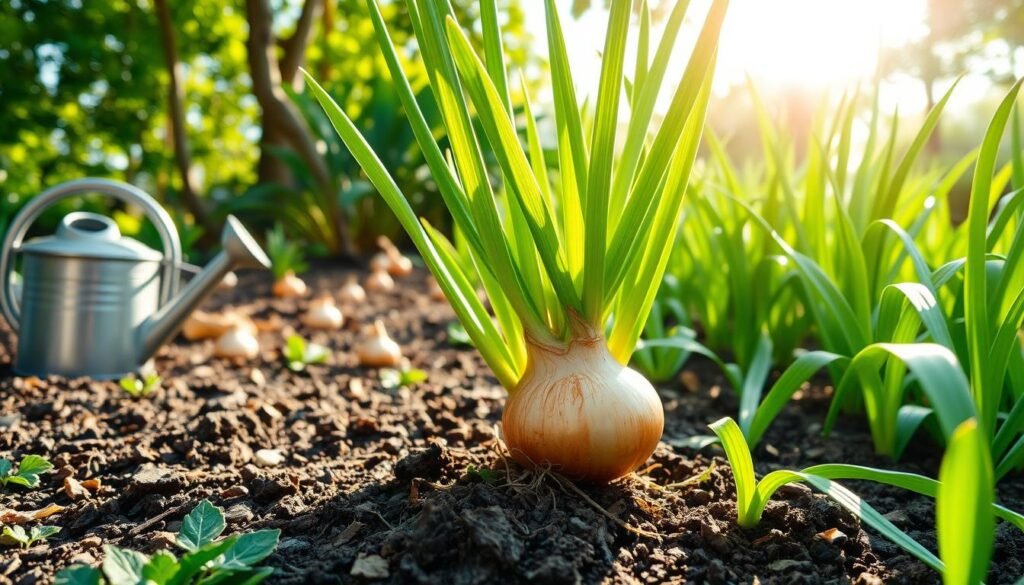
| Factor | Requirement |
|---|---|
| Watering | 1 inch per week |
| Sunlight | Minimum 6 hours daily |
| Soil Moisture | Check weekly for dryness |
| Soil Type | Well-drained, pH 6.0-7.0 |
Harvesting Onions: When and How to Harvest
Harvesting onions at the right time is key for the best taste and storage. You need to know when they’re ready. Onions usually take 90-120 days to grow. Watch your plants closely as harvest time approaches.
Signs Your Onion is Ready to Harvest
Knowing signs of onion readiness is important. Look for these signs:
- About two-thirds of the tops have fallen over and dried naturally.
- Foliage is 80% dieback, showing the onions are sweet and ready.
- The outer layers of the bulb are firm to the touch.
These signs mean your onions are ready to harvest safely. Pay close attention to these details for the best results.
How to Harvest Without Damaging the Bulb
Proper harvesting techniques are vital for onion quality. To harvest safely:
- Gently loosen the soil around the onion base with a shovel or your hands.
- Pull onions by the green stems, avoiding force.
- After pulling, let onions dry without washing, gently removing dirt.
These steps help keep the bulb intact. This ensures better storage and longer shelf life. After harvesting, use the right curing and storage methods to keep onions fresh.
Storing Your Harvested Onions
After harvesting your onions, it’s important to store them right. This helps keep them fresh for longer. Here, we’ll cover the best ways to cure and store onions for a long time.
Best Practices for Curing Onions
Curing onions is a key step in keeping them fresh. It involves drying them in a warm, airy spot until the tops dry out. This can take 2 to 6 weeks. Proper curing helps onions stay fresh and prevents spoilage.
- Choose a dry area with good air circulation for curing.
- Place onions in a single layer to facilitate even drying.
- Avoid direct sunlight to prevent overheating and deterioration.
- Monitor the onions during the curing process to ensure they are drying properly.
Long-term Storage Tips
After curing, it’s time to store your onions for the long haul. The best storage temperature is between 35 to 40 degrees Fahrenheit. Here are some tips for storing onions:
- Use breathable containers like mesh bags or baskets to prevent moisture buildup.
- Store onions in a cool, dark, and dry place to maintain quality.
- Mild onion varieties should be consumed within a few weeks, while pungent onions can last 10 to 12 months when stored properly.
- Ensure humidity levels stay around 65-75% to avoid sprouting and rot.
The table below outlines the storage duration of various onion types:
| Onion Type | Storage Duration |
|---|---|
| Mild Varieties (e.g., Spanish, Vidalia) | 1-3 months |
| Pungent Varieties (e.g., Candy, Red Weathersfield) | 10-12 months |
| Storage Onions (e.g., long-day types) | 3-9 months |
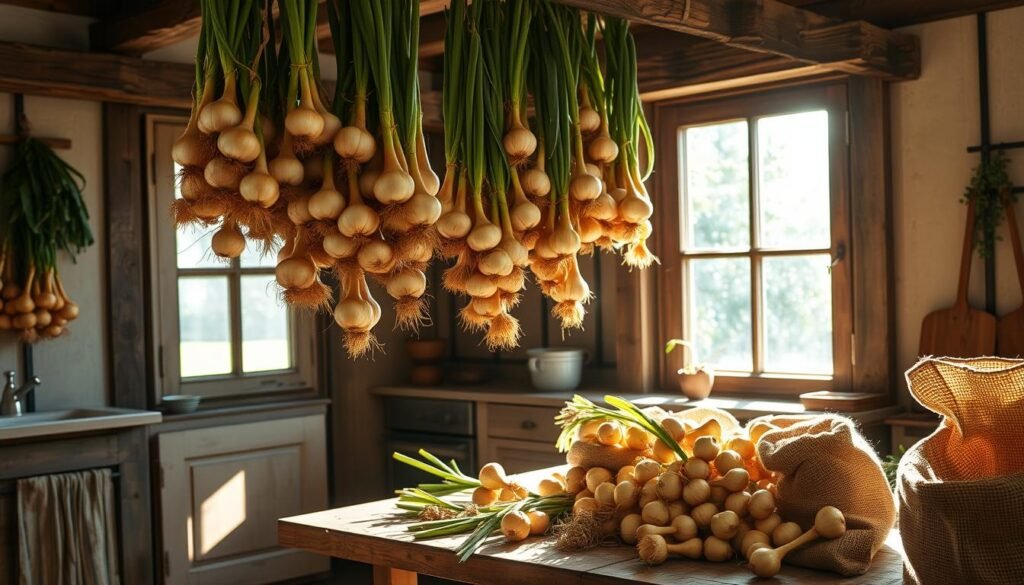
By using good curing and storage methods, you can enjoy your onions for months. Following these tips will help you preserve your onions and enjoy your garden’s bounty.
Common Challenges in Onion Cultivation
Onion gardening comes with its own set of challenges. These can affect your harvest’s quality and quantity. It’s important to know how to tackle these issues to keep your onions healthy and productive. You might face problems like pests, diseases, and environmental factors that impact growth.
Pests and Diseases
Dealing with pests in onion gardening is a big challenge. Pests like the onion fly can harm your crop. Also, diseases like downy mildew and neck rot can threaten your plants. It’s key to watch for signs of trouble in your garden.
Using natural pest control can help protect your onions. Crop rotation and good soil health also play a role in keeping pests and diseases away.
Environmental Factors to Consider
Environmental factors greatly affect onion growth. Temperature changes, for example, can impact bulb size, as seen in places like Arkansas. To grow onions well, choose the right time and place for planting.
Make sure onions get enough sunlight. Also, space them correctly based on the variety. These steps can help overcome environmental challenges in onion farming.
| Challenge | Impact | Mitigation Strategies |
|---|---|---|
| Pests in Onion Gardening | Decreased yields; damage to bulbs | Regular monitoring; organic pest control |
| Onion Diseases | Plant mortality; reduced quality | Crop rotation; improve soil health |
| Environmental Challenges | Inconsistent growth; poor bulb development | Optimal planting times; adequate sunlight |
Conclusion
Growing onions from scraps is a rewarding experience. It introduces you to sustainable gardening practices. By learning the basics of onion propagation, you can start your gardening journey with confidence.
Whether you plant in pots or directly in the ground, this method reduces waste. It also helps you get the most from your onions.
As you explore successful onion gardening, remember to care for your onions well. Make sure to space them 6 inches apart. Choose the right onion variety for a bountiful harvest.
This approach not only saves money but also helps the environment. It’s a win-win for your wallet and the planet.
With patience and the right practices, you’ll enjoy the rewards of your hard work. Harvesting fresh onions brings joy and enhances your cooking. Plus, you’ll know you’re doing something good for the planet.

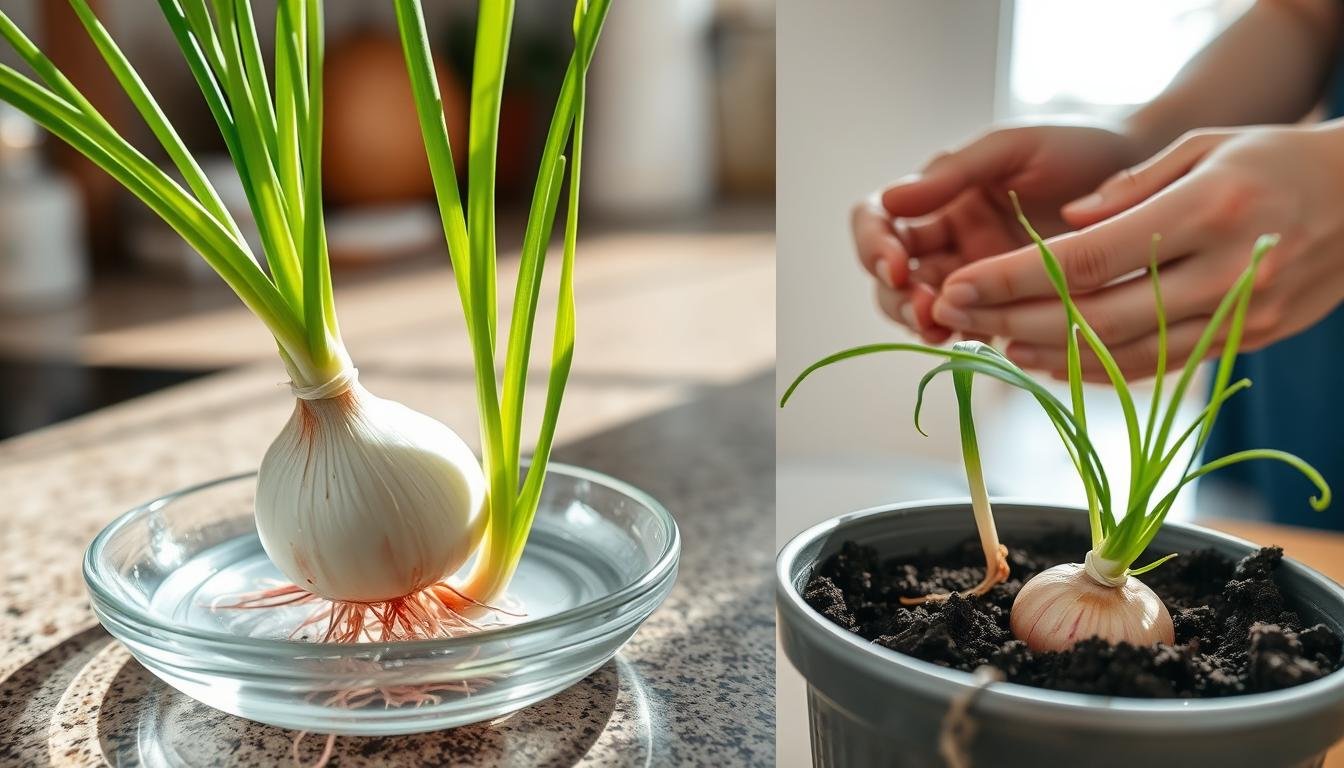
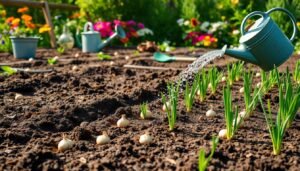
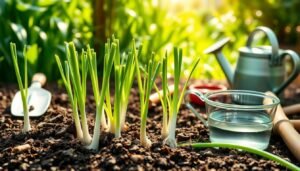
Pingback: how to grow green onions – Tips & Tricks
Pingback: Master How to Grow Onion in Your Garden
Pingback: How to Grow Carrots From Scraps
Pingback: Is it Too Late to Plant Garlic? Best Planting Times Guide
Pingback: Grow Vegetables on Balcony: Best Beginner's Guide
Pingback: How to Grow Vegetables on the Garden Successfully
Pingback: Growing Blueberry Plants: Expert Tips for Your Garden | CropTap
Pingback: Growing Chinese Lantern Plant: Care and Cultivation Tips
Pingback: Creative Cactus Garden Ideas for Your Desert Oasis
Pingback: Garden Shed Organization Ideas for Better Storage